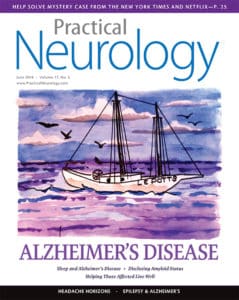By: Erin Alessandroni
As advances in imaging and other technologies continue to take place, clinicians will have the ability to diagnose Alzheimer’s disease (AD) years before the onset of clinical symptoms. This progress may present difficulties, such as informing cognitively healthy individuals of potentially distressing information.
Kristin Harkins, MPH and Jason Karlawish, MD, both of the Penn Memory Center, provide considerations clinicians must make when disclosing amyloid status to a person without cognitive impairments in an article published to Practical Neurology.
Biomarkers (biological markers) such as amyloid plaques may represent the earliest detectable evidence of Alzheimer’s disease, with buildup beginning 10 to 15 years before symptoms appear. When technologies such as Positron Emission Tomography (PET) scans make the presence of this biomarker visible in patients, the diagnosis is referred to as asymptomatic at risk for AD or preclinical AD.
The current best practices for disclosure of amyloid imaging results in research begin with education by a skilled communicator using standardized text to explain the meanings of possible results. After assessing the patient’s mental health, the clinician judges whether the patient can proceed with the PET scan.
After the PET scan, the patient undergoes another psychological evaluation to judge whether or not to proceed, following which results are disclosed responsibly. The last stage is a post-disclosure follow up visit during which well-being, distress, and impact of disclosure are monitored and an appropriate follow-up plan is created.
Eventually, clinicians will use biomarkers to diagnose AD in individuals who are cognitively unimpaired and prescribe interventions and treatments to prevent or delay the onset of symptoms. This translation of preclinical AD from a research designation to a clinical diagnosis may present challenges, according to Harkins and Dr. Karlawish.
The considerations clinicians must make when diagnosing AD in a person without cognitive impairment came from a PMC study titled Study of Knowledge and Reactions to Amyloid Testing (SOKRATES). Part of this study evaluated how disclosure of amyloid imaging results affected participants’ daily life, behaviors, responsibilities, and relationships, and how the participants perceived their future — in addition to whom they disclosed their results to and why.
The first consideration is prognostic uncertainty. Up to 30 percent of adults over age 65 without cognitive impairment have amyloid deposits and a higher risk of developing AD. This being said, there is currently no way to tell who will remain asymptomatic throughout their lives and who will develop clinical AD. According to the SOKRATES study, research participants can be frustrated with how their result is only described as either “elevated” or “not elevated” amyloid, rather than an exact percentage or rate.
The other considerations clinicians must make involve the psychological and emotional challenges patients may face, as well as possible changes to their relationships and sense of self. In addition, clinicians must be prepared to help patients make decisions about their lifestyles, behaviors, and future plans.
The potential for adverse psychological effects and catastrophic reactions is an important consideration, and clinicians will need to weigh the benefit of providing a preventative treatment with the risks associated with disclosure.
For the full paper, please click here.


